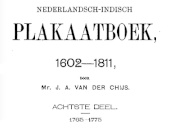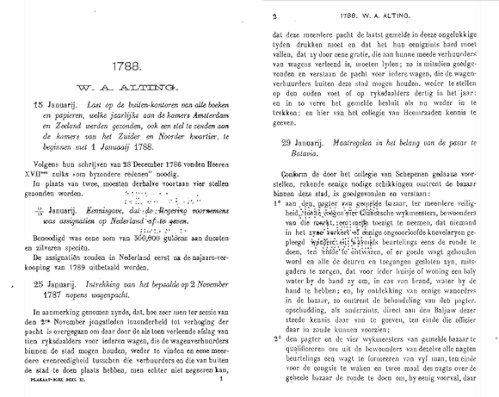The Placards of Batavia Castle 1602–1808

In its centre of administration, Batavia Castle, the Supreme Government of the VOC in Asia issued thousands of placards (formal announcements), bans, decrees, regulations and notifications during the 17th and 18th centuries. Many of these decrees or ‘plakaten’ (placards) were issued in public and nailed to the door of the Town Hall (Stadhuis) or other such visible public places. Most of the placards were meant to regulate the markets, public leases, institutions, population (most notably the Chinese) and public civil behaviour of Batavia. A number of other placards concern regulations for VOC personnel, trade, maritime matters, repatriation and salaries. The administration of the villages and regents (bupati) of Priangan also feature frequently in these placards or announcements.

A ‘placard’ is – according to Dutch archive terminology – ‘an ordinance destined for general publication, issued with a printed seal’, the ‘placard’. The term ‘Law’ had several meanings during the ‘Ancien Regime’ in Europe or the VOC era (1609-1799). In eighteenth-century parlance, laws should be formalized decisions meant for the public, issued by placard at the usual places in town. Like the publication of placards in the Dutch Republic (for instance the ‘Groot Placaatboek van Utrecht’), the Placards of Batavia Castle are a rather arbitrary mixture of all sorts of laws and regulations. The Placards issued by the Political Council in Colombo are published in L. Hovy, Ceylonees plakkaatboek (2 volumes, Hilversum: Verloren, 1995).
The former Landsarchief (Colonial Archives), present-day ANRI, was and is the only place where one can find this collection of placards and decrees. It was the first series of Landsarchief archives selected for publication in the 19th century by the then keeper of the Batavia State Archives, J.A. van der Chijs. The first volume was published in 1885 by the Bataviaasch Genootschap van Kunsten en Wetenschappen (Batavian Society of Arts and Sciences, 1778-1962).
It is not clear just how comprehensive this 17-volume placard source publication actually was. What we do know is that it was overseen by the Landsarchivaris (chief archivist), J.A. van der Chijs, between 1885-1900. Van der Chijs does not provide any source references. But it is clear from his introduction to Volume 1 that he had opted for a very wide selection. He also included resolutions concerning individuals which were not meant for general publication. Notifications, such as the notification of public prayer days, are also included.
Continue to browse the Placards >>
RESEARCH DATA OF THE PLACARDS
You may download the data set of the placards here for your own research and analysis.
Dataset on placards v20150127:





